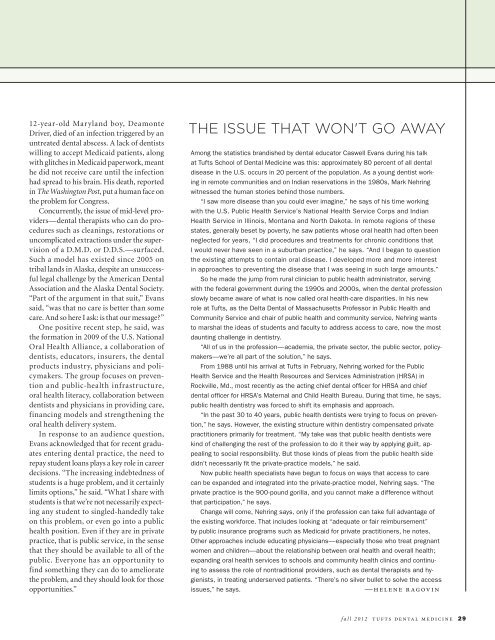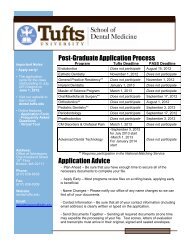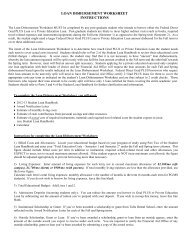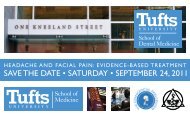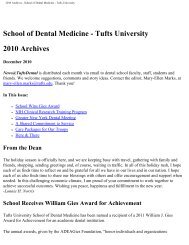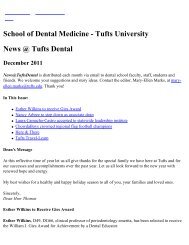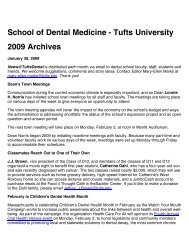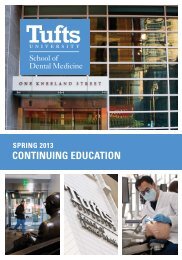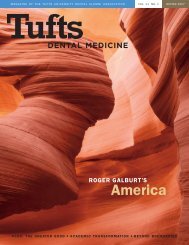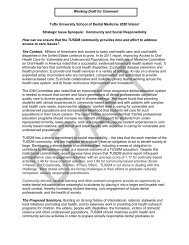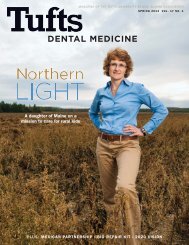Download the latest version - Tufts University School of Dental ...
Download the latest version - Tufts University School of Dental ...
Download the latest version - Tufts University School of Dental ...
Create successful ePaper yourself
Turn your PDF publications into a flip-book with our unique Google optimized e-Paper software.
12-year-old Maryland boy, Deamonte<br />
Driver, died <strong>of</strong> an infection triggered by an<br />
untreated dental abscess. A lack <strong>of</strong> dentists<br />
willing to accept Medicaid patients, along<br />
with glitches in Medicaid paperwork, meant<br />
he did not receive care until <strong>the</strong> infection<br />
had spread to his brain. His death, reported<br />
in The Washington Post, put a human face on<br />
<strong>the</strong> problem for Congress.<br />
Concurrently, <strong>the</strong> issue <strong>of</strong> mid-level providers—dental<br />
<strong>the</strong>rapists who can do procedures<br />
such as cleanings, restorations or<br />
uncomplicated extractions under <strong>the</strong> supervision<br />
<strong>of</strong> a D.M.D. or D.D.S.—surfaced.<br />
Such a model has existed since 2005 on<br />
tribal lands in Alaska, despite an unsuccessful<br />
legal challenge by <strong>the</strong> American <strong>Dental</strong><br />
Association and <strong>the</strong> Alaska <strong>Dental</strong> Society.<br />
“Part <strong>of</strong> <strong>the</strong> argument in that suit,” Evans<br />
said, “was that no care is better than some<br />
care. And so here I ask: is that our message?”<br />
One positive recent step, he said, was<br />
<strong>the</strong> formation in 2009 <strong>of</strong> <strong>the</strong> U.S. National<br />
Oral Health Alliance, a collaboration <strong>of</strong><br />
dentists, educators, insurers, <strong>the</strong> dental<br />
products industry, physicians and policymakers.<br />
The group focuses on prevention<br />
and public-health infrastructure,<br />
oral health literacy, collaboration between<br />
dentists and physicians in providing care,<br />
financing models and streng<strong>the</strong>ning <strong>the</strong><br />
oral health delivery system.<br />
In response to an audience question,<br />
Evans acknowledged that for recent graduates<br />
entering dental practice, <strong>the</strong> need to<br />
repay student loans plays a key role in career<br />
decisions. “The increasing indebtedness <strong>of</strong><br />
students is a huge problem, and it certainly<br />
limits options,” he said. “What I share with<br />
students is that we’re not necessarily expecting<br />
any student to singled-handedly take<br />
on this problem, or even go into a public<br />
health position. Even if <strong>the</strong>y are in private<br />
practice, that is public service, in <strong>the</strong> sense<br />
that <strong>the</strong>y should be available to all <strong>of</strong> <strong>the</strong><br />
public. Everyone has an opportunity to<br />
find something <strong>the</strong>y can do to ameliorate<br />
<strong>the</strong> problem, and <strong>the</strong>y should look for those<br />
opportunities.”<br />
<strong>the</strong> issue that won't go away<br />
among <strong>the</strong> statistics brandished by dental educator Caswell evans during his talk<br />
at <strong>Tufts</strong> <strong>School</strong> <strong>of</strong> dental Medicine was this: approximately 80 percent <strong>of</strong> all dental<br />
disease in <strong>the</strong> U.S. occurs in 20 percent <strong>of</strong> <strong>the</strong> population. as a young dentist working<br />
in remote communities and on Indian reservations in <strong>the</strong> 1980s, Mark nehring<br />
witnessed <strong>the</strong> human stories behind those numbers.<br />
“I saw more disease than you could ever imagine,” he says <strong>of</strong> his time working<br />
with <strong>the</strong> U.S. Public Health Service’s national Health Service Corps and Indian<br />
Health Service in Illinois, Montana and north dakota. In remote regions <strong>of</strong> <strong>the</strong>se<br />
states, generally beset by poverty, he saw patients whose oral health had <strong>of</strong>ten been<br />
neglected for years, “I did procedures and treatments for chronic conditions that<br />
I would never have seen in a suburban practice,” he says. “and I began to question<br />
<strong>the</strong> existing attempts to contain oral disease. I developed more and more interest<br />
in approaches to preventing <strong>the</strong> disease that I was seeing in such large amounts.”<br />
So he made <strong>the</strong> jump from rural clinician to public health administrator, serving<br />
with <strong>the</strong> federal government during <strong>the</strong> 1990s and 2000s, when <strong>the</strong> dental pr<strong>of</strong>ession<br />
slowly became aware <strong>of</strong> what is now called oral health-care disparities. In his new<br />
role at <strong>Tufts</strong>, as <strong>the</strong> delta dental <strong>of</strong> Massachusetts Pr<strong>of</strong>essor in Public Health and<br />
Community Service and chair <strong>of</strong> public health and community service, nehring wants<br />
to marshal <strong>the</strong> ideas <strong>of</strong> students and faculty to address access to care, now <strong>the</strong> most<br />
daunting challenge in dentistry.<br />
“all <strong>of</strong> us in <strong>the</strong> pr<strong>of</strong>ession—academia, <strong>the</strong> private sector, <strong>the</strong> public sector, policymakers—we’re<br />
all part <strong>of</strong> <strong>the</strong> solution,” he says.<br />
From 1988 until his arrival at <strong>Tufts</strong> in February, nehring worked for <strong>the</strong> Public<br />
Health Service and <strong>the</strong> Health Resources and Services administration (HRSa) in<br />
Rockville, Md., most recently as <strong>the</strong> acting chief dental <strong>of</strong>ficer for HRSa and chief<br />
dental <strong>of</strong>ficer for HRSa’s Maternal and Child Health Bureau. during that time, he says,<br />
public health dentistry was forced to shift its emphasis and approach.<br />
“In <strong>the</strong> past 30 to 40 years, public health dentists were trying to focus on prevention,”<br />
he says. However, <strong>the</strong> existing structure within dentistry compensated private<br />
practitioners primarily for treatment. “My take was that public health dentists were<br />
kind <strong>of</strong> challenging <strong>the</strong> rest <strong>of</strong> <strong>the</strong> pr<strong>of</strong>ession to do it <strong>the</strong>ir way by applying guilt, appealing<br />
to social responsibility. But those kinds <strong>of</strong> pleas from <strong>the</strong> public health side<br />
didn’t necessarily fit <strong>the</strong> private-practice models,” he said.<br />
now public health specialists have begun to focus on ways that access to care<br />
can be expanded and integrated into <strong>the</strong> private-practice model, nehring says. “The<br />
private practice is <strong>the</strong> 900-pound gorilla, and you cannot make a difference without<br />
that participation,” he says.<br />
Change will come, nehring says, only if <strong>the</strong> pr<strong>of</strong>ession can take full advantage <strong>of</strong><br />
<strong>the</strong> existing workforce. That includes looking at “adequate or fair reimbursement”<br />
by public insurance programs such as Medicaid for private practitioners, he notes.<br />
O<strong>the</strong>r approaches include educating physicians—especially those who treat pregnant<br />
women and children—about <strong>the</strong> relationship between oral health and overall health;<br />
expanding oral health services to schools and community health clinics and continuing<br />
to assess <strong>the</strong> role <strong>of</strong> nontraditional providers, such as dental <strong>the</strong>rapists and hygienists,<br />
in treating underserved patients. “There’s no silver bullet to solve <strong>the</strong> access<br />
issues,” he says. —helene ragovin<br />
fall 2012 tufts dental medicine 29


